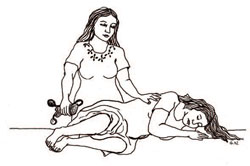Emergency treatment for epilepsy
Epilepsy is not usually a life-threatening condition. However, a small number of people die from epilepsy each year, usually as a result of accidents or status epilepticus (see below). In this section you will learn what you can do if you come across someone during a seizure.
The best response to a seizure attack is simply to prevent the person from self-injury by moving them away from dangerous sharp edges, placing a soft pillow under their head, and carefully rolling the person into the safe lateral position (see Figure 15.2). To prevent injury, objects should not be placed in the person's mouth during the seizure. It is also important not to light matches, give the person anything to drink, or to try to stop the fit by force or by holding them tight.
This is a position in which the person is put on their side, to avoid fluid going into the lungs.

If a seizure lasts longer than five minutes (or the seizures begin to come in 'waves' one after the other), this may be a sign of status epilepticus. Although rare, status epilepticus is a serious medical emergency characterised by two or more seizures occurring in succession without the person regaining consciousness.
This may occur because of the sudden discontinuation of antiepileptic drugs, alcohol withdrawal (in chronic alcoholics), or as the result of an infection of the central nervous system or an accident involving trauma to the head. Status epilepticus could occur without previous history of seizure disorder. Individuals with status epilepticus can be helped by being put in the safe lateral position, by checking blood pressure frequently, and by referring them urgently to the nearest general hospital, accompanied by a close relative or yourself.
After a seizure (whether as a single fit or status epilepticus), the person should not be allowed to wander about unsupervised until they have returned to their normal level of awareness. The person should remain observed until they have completely recovered. It is helpful if those present at the time of a seizure make notes (see the section on seizure diaries at the end of Section 15.1.4) as these could prove useful in diagnosis.